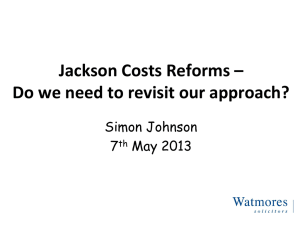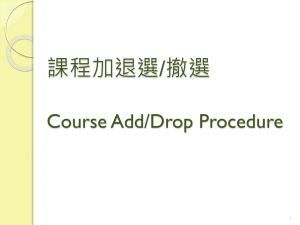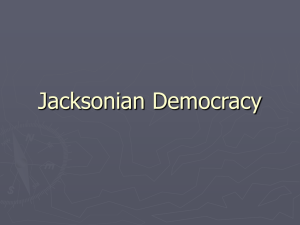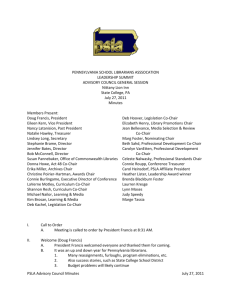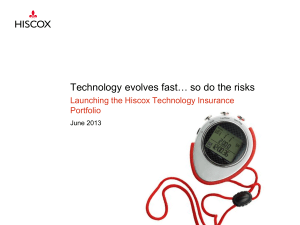The Jackson Reforms 2013 e-update
advertisement
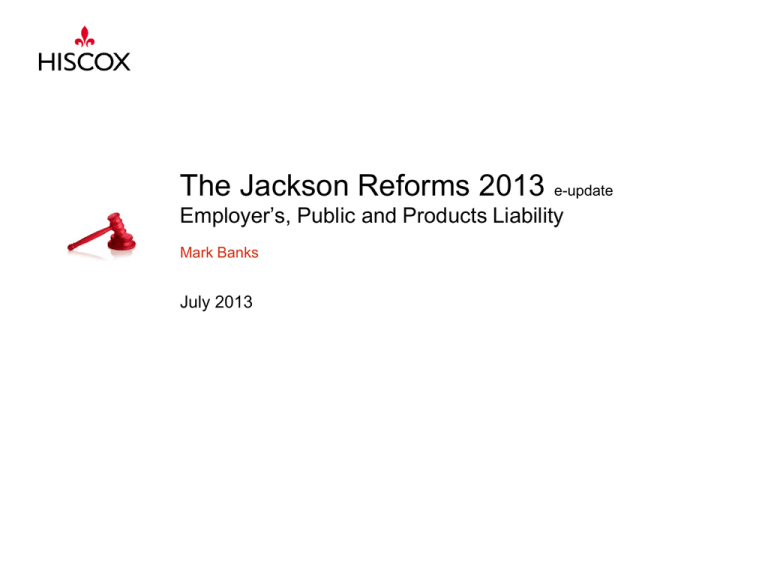
The Jackson Reforms 2013 e-update Employer’s, Public and Products Liability Mark Banks July 2013 The Jackson Reform 1st April, 2013 saw the introduction of initial changes to the Civil Procedure Rules following Lord Jackson’s proposals for Civil Justice Reform. 31st July 2013 saw the completion of the implementation of those reforms. These changes will affect the procedure for making a claim, the time-scales within which a claim is to be managed, the way in which a claimant’s claim is funded and the amount in costs which will be recoverable by the claimant from the defendant. This document will provide information to ensure compliance with the new rules and also to make the most of the changes to control claims spend and so improve a policyholder’s claims history. 2 The Jackson Reform – The Headlines • As of 31st July 2013, the Claims Portal goes live. • Defendants cannot recover their defence costs from an unsuccessful claimant (QOCS). • Hiscox have appointed preferred solicitors to monitor the Claims Portal and deal • ATE premiums and success fees are no with applicable claims received. longer recoverable as part of a costs settlement. • Speed is of the essence. Record accidents immediately and report them to your • Claims can be funded by BTE, ATE, CFA, broker. DBA arrangements. • Investigation timescales have reduced; • Interim payment requests will become very we now have only 6 weeks for Employers common within the Claims Portal. Liability (EL) and 8 weeks for Public • Claimants will present a Settlement Pack, Liability (PL) to make a liability decision. including an offer, once they have all their • General Damages / PSLA payments will evidence collated. increase by 10%. • There will be no more Letters of Claim on • A claimants costs will be fixed within the Fast-Track matters. A CNF or DCNF will Claims Portal. be used. 3 Things for the Insured to do • All accidents and alleged accidents must be recorded straight away and reported to the broker. • Retain all accident reports and associated documents / items (as set out below) for at least 3 ½ years from the date of the accident. • Upon receipt of a DCNF, an electronic acknowledgement should be sent in reply within 1 business day and the insurer advised immediately. Hiscox name and the policy number should be given. • The accident record should include HSE / RIDDOR / COSHH, identity of the injured party, a narrative of circumstances, photographs, witness names and statements, CCTV, pre and post accident risk assessments, system of working, training records, wages information and any further relevant information. • Advise Hiscox immediately of any concerns over validity or opinions on liability. With speed being “of the essence” early admissions will be preferable – but only where appropriate. IT WOULD BE IDEAL FOR AN INSURED TO NOMINATE AN INSURANCE LIAISON TO ENSURE COMPLIANCE AND SPEED 4 The Claims Process • Most Fast-track Employers and Public Liability losses will be notified to Hiscox, via the Claims Portal, using a CNF. • Where the insurer is not known, the notification will be sent directly to the insured by DCNF. • All notifications must be electronically acknowledged to the claimant within 1 business day. • Decisions on liability are required within 30 working days for EL and 40 for PL. • Wages information is required within 20 further working days. • Once the claimant has submitted their Settlement Pack, there are up to 35 working days within which settlement is to be agreed. • Counter offers must be made within 15 working days of receipt of the Settlement Pack. • If a claim is dealt with within the Claims Portal, lower Fixed Costs will be payable. FAILURE TO MEET THESE MEASURES WILL RESULT IN THE CLAIM LEAVING THE CLAIMS PORTAL 5 Benefits • The reform is good news for defendants. Whilst there is to be a 10% uplift in the value of injuries, this will be offset by the restrictions in the costs recoverable by the claimant. • Within the Portal:– Claims up to £10k in damages will attract costs of £900.00 + VAT & disbursements – Claims between £10k & £25k will attract costs of £1600.00 + VAT & disbursements – Pre-reform, such claims may have attracted costs of £5-10k plus. • Outside the Portal:– ATE insurance premiums and success fees are not recoverable from the defendant – Qualified One-way Costs Shifting (QOCS) will apply – Claims will be funded either by CFA or DBA – Claimant Costs will be fixed, but at a higher value - This position is illustrated in the examples. • To settle the claim within the portal will reduce claims spend considerably. 6 Effect of Jackson on Claim Values Pre Jackson Reform Low Value £1k - £10k Fast Track Personal Injury Claim General Damages £5,000.00 £5,500.00 Special Damages £1,000.00 £1,000.00 Costs £6,000.00 £1,080.00 Disbursements Total £500.00 £12,500.00 £500.00 £8,080.00 Pre Jackson Reform Low Value £10k - £25k Fast Track Personal Injury Claim includes 10% uplift in PSLA award £15,000.00 £16,500.00 Special Damages £5,000.00 £5,000.00 Costs £10,000.00 £1,920.00 Disbursements Total £1,000.00 £31,000.00 £1,000.00 £24,420.00 Post Jackson (non-portal) £5,500.00 includes 10% uplift in PSLA award £1,000.00 £900 + VAT £3,201.00 £1,855 + 12.5% damages + VAT £500.00 £10,201.00 Post Jackson (in portal) General Damages Pre Jackson Reform Multi Track Personal Injury Claim Post Jackson (in portal) includes 10% uplift in PSLA award Post Jackson (non-portal) £16,500.00 includes 10% uplift in PSLA award £5,000.00 £1600 + VAT Post Jackson (in portal) £5,900.00 £1,000.00 £28,400.00 Post Jackson (non-portal) General Damages £100,000.00 £110,000.00 Special Damages £20,000.00 £20,000.00 Costs £50,000.00 Disbursements Total £5,000.00 £175,000.00 NOT APPLICABLE £2,500 + 10% damages + VAT £30,000.00 includes 10% uplift in PSLA award hourly rate - but no ATE or success fee £5,000.00 £165,000.00 The above is illustrative only. Where a claim leaves the portal, costs are broken down into 3 groups, £1k - £5k, £5k - £10k and £10k - £25k 7 Process Diagram EL/PL Fast-track 8 Glossary (1) • ATE – After The Event Insurance • – The insurance bought by a claimant to fund their claim. The premium is no longer recoverable from the defendant • BTE – Before The Event Insurance – This is the mechanism by which new claims are notified via The Claims Portal. • – A pre arranged policy taken out to fund possible future claims – often attached to a home or motor policy • CFA – Conditional Fee Agreement – “No Win – No Fee”. A claimant does not pay their solicitor’s fees if the claim is unsuccessful • • • • Civil Procedure Rules – The CPR The Claims Portal – The IT system by which applicable claims are notified and managed DBA – Damages Based Agreements – A mechanism for funding a claim, whereby a claimant pays their solicitor a proportion of their damages award as part of the solicitor’s fee. Fast Track (personal injury values) – The 2nd tier of claims under the CPR for damages valued at between £1,000 and £25,000 – The rules introduced by Lord Woolf in 1999 and updated in this reform by Lord Jackson, specific to compensation claims process • COSHH – Control of Substances Hazardous to Health Regulations 2002 – Incidents involving harmful substances must be reported on a COSHH form Civil Justice Reform – Lord Jackson’s reform of the Civil Procedure Rules CNF / DCNF – (Direct) Claims Notification Form – Small Claims Track - for claims less than £1,000 – Multi Track - for all claims over £25,000 • Fixed Costs – Within The Claims Portal a claimant solicitor can recover only fixed costs from the defendant Return to page 3 4 5 6 9 Glossary (2) • General Damages (also see PSLA) • – The compensation for the injury and other heads of claim which are not able to be documented. – Special Damages being those losses which are specifically defined such as cost of past care or lost earnings. • • – All accidents / incidents where injury either occurred or could have occurred are reportable to the HSE under this regulation. A copy of the reporting form should be retained HSE – The Health and Safety Executive – The Government body specifically concerned with H&S at work and in public places • PSLA - Pain Suffering & Loss of Amenity – The Injury element of the General Damages • QOCS – Qualified One-way Costs Shifting – Where a CFA was entered into after 1st April 2013, QOCS applies. This means that a defendant cannot recover their defence costs from the other side if they succeed in their defence – this is the balance to the claimant not being able to recover ATE premiums or success fees. – Settlement Pack – Once an admission of liability is made in The Claims Portal, the claimant solicitor presents all the information required to document their client’s claim. Letter(s) of Claim – Under the previous rules, a claim was formally presented by way of such a letter, setting out the details and the allegations. This is now replaced by the CNF / DCNF • RIDDOR – Reporting of Injuries Diseases & Dangerous Occurrences Regulations 1995 – Medical report(s), specialist legal advice, evidence of Special Damages, witness statements and most importantly the value of the offer to settle • Wages Information – On EL cases, the insured needs to provide the insurer with details of 13 weeks pre accident earnings for the claimant (net of NI & Tax) and also details of all wage payments made subsequently, covering any periods of absence related to the accident and the injury suffered There are some exceptions, such as fraud cases Return to page 3 4 5 6 10
